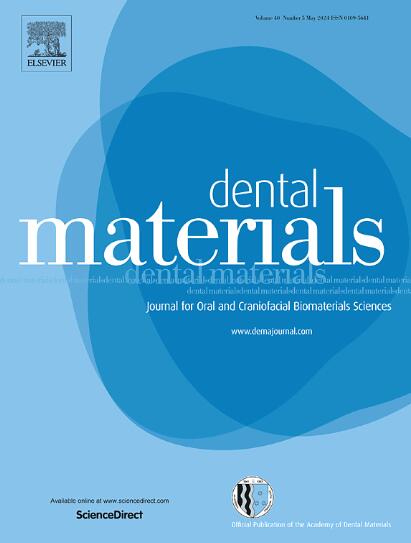3D micro-CT and O-PTIR spectroscopy bring new understanding of the influence of filler content in dental resin composites
IF 4.6
1区 医学
Q1 DENTISTRY, ORAL SURGERY & MEDICINE
引用次数: 0
Abstract
Background
Dental resin composites' performance is intricately linked to their polymerisation shrinkage characteristics. This study compares polymerisation shrinkage using advanced 3D micro-computed tomography (micro-CT) and traditional 2D linear assessments. It delves into the crucial role of filler content on shrinkage and the degree of conversion in dental resin composites, providing valuable insights for the field.
Methods
Five experimental dental composite materials were prepared with increasing filler contents (55–75 wt%) and analysed using either 3D micro-CT for volumetric shrinkage or a custom-designed linometer for 2D linear shrinkage. The degree of conversion was assessed using Optical Photothermal Infrared (O-PTIR) and Fourier-Transform Infrared (FTIR) spectroscopy. Light transmittance through a 2-mm layer was evaluated using a NIST-calibrated spectrometer. Scanning Electron Microscopy (SEM) and Energy-Dispersive X-ray Spectroscopy (EDX) examined surface morphology and elemental distribution. Correlation between the investigated parameters was determined using Spearman correlation analyses.
Results
The study found significant differences in polymerisation-related properties among different filler content categories, with volumetric shrinkage consistently demonstrating higher mean values than linear shrinkage across most groups. Volumetric shrinkage decreased with increasing curing depth, showing no direct correlation between filler content and shrinkage levels at different curing depths. The results highlighted a strong negative correlation between filler content and degree of conversion, volumetric and linear shrinkage, as well as maximum shrinkage rate. Light transmittance showed a moderate correlation with the filler content and a weak correlation with other tested parameters.
Conclusions
This study underscores the importance of considering both volumetric and linear shrinkage in the design and analysis of dental composite materials. The findings advocate optimising filler content to minimise shrinkage and enhance material performance. Integrating micro-CT and O-PTIR techniques offers novel insights into dental composites' polymerisation behaviour, providing a foundation for future research to develop materials with improved clinical outcomes.
三维显微计算机断层扫描和 O-PTIR 光谱技术使人们对牙科树脂复合材料中填料含量的影响有了新的认识。
背景:牙科树脂复合材料的性能与其聚合收缩特性密切相关。本研究使用先进的三维微型计算机断层扫描(micro-CT)技术和传统的二维线性评估技术对聚合收缩进行了比较。研究深入探讨了填料含量对牙科树脂复合材料收缩率和转化程度的关键作用,为该领域提供了有价值的见解:方法:制备了五种填充物含量不断增加(55-75 wt%)的实验性牙科复合材料,并使用三维显微计算机断层扫描(3D micro-CT)进行体积收缩分析,或使用定制设计的线性收缩仪进行二维线性收缩分析。采用光学光热红外光谱(O-PTIR)和傅立叶变换红外光谱(FTIR)评估转化程度。使用经 NIST 校准的光谱仪评估通过 2 毫米层的透光率。扫描电子显微镜(SEM)和能量色散 X 射线光谱(EDX)检查了表面形态和元素分布。使用斯皮尔曼相关分析确定了研究参数之间的相关性:研究发现,不同填料含量类别的聚合相关特性存在显著差异,在大多数组别中,体积收缩率的平均值始终高于线性收缩率。体积收缩率随着固化深度的增加而降低,这表明填料含量与不同固化深度下的收缩率之间没有直接关联。结果表明,填料含量与转化程度、体积收缩率和线性收缩率以及最大收缩率之间存在很强的负相关。透光率与填料含量呈中度相关,与其他测试参数的相关性较弱:这项研究强调了在设计和分析牙科复合材料时考虑体积收缩和线性收缩的重要性。研究结果主张优化填料含量,以尽量减少收缩并提高材料性能。将显微 CT 和 O-PTIR 技术相结合,可为牙科复合材料的聚合行为提供新的见解,为未来研究开发具有更好临床效果的材料奠定基础。
本文章由计算机程序翻译,如有差异,请以英文原文为准。
求助全文
约1分钟内获得全文
求助全文
来源期刊

Dental Materials
工程技术-材料科学:生物材料
CiteScore
9.80
自引率
10.00%
发文量
290
审稿时长
67 days
期刊介绍:
Dental Materials publishes original research, review articles, and short communications.
Academy of Dental Materials members click here to register for free access to Dental Materials online.
The principal aim of Dental Materials is to promote rapid communication of scientific information between academia, industry, and the dental practitioner. Original Manuscripts on clinical and laboratory research of basic and applied character which focus on the properties or performance of dental materials or the reaction of host tissues to materials are given priority publication. Other acceptable topics include application technology in clinical dentistry and dental laboratory technology.
Comprehensive reviews and editorial commentaries on pertinent subjects will be considered.
 求助内容:
求助内容: 应助结果提醒方式:
应助结果提醒方式:


